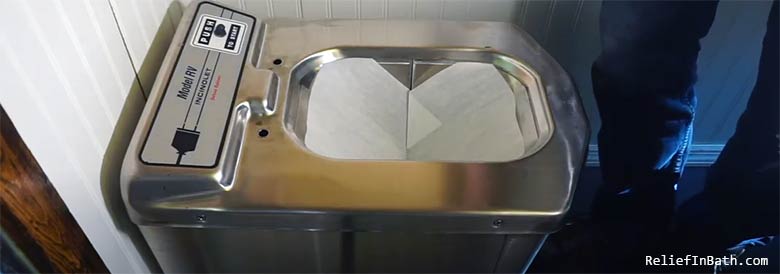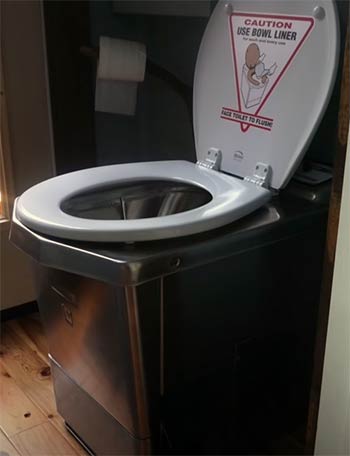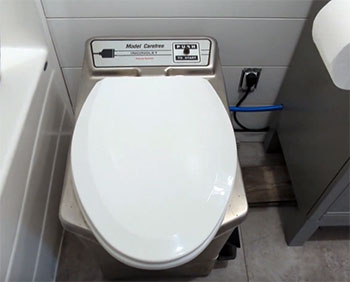For people who prefer to keep their septic system healthy, incinolet toilets are a great choice. It is an eco-friendly and practical choice in different living environments.
Do you have any Incinolet toilets awful experience? If yes, what are they?
No matter which type of toilets you use, each has pros and cons. After all, they are not suitable for all conditions and humans.
In fact, some unique situations and particular levels of people can benefit from a specific toilet system.
Overview of Incinolet Toilets
Before diving into the many issues with incinolet toilets, it’s important to understand the basic technology behind them.
Incinolet toilets consist of a typical toilet bowl connected to an incinerator chamber below. After using the toilet, waste drops into the incinerator where an electric heating element burns it at high temperatures until it turns to ash. Fans and filters are used to control odors and vent the ash into a collection container.
Some key features include:
- Electric heating element – Burns waste at temperatures from 1500-2000°F. Requires significant power.
- Steel incineration chamber – The combustion chamber where burning occurs. Prone to corrosion over time.
- Ash collection container – Collects the burned waste residue for later disposal. Typically needs emptied weekly.
- Ventilation system – Fans and filters to control odors. Critics claim they are often ineffective.
- Porcelain bowl – Made from typical toilet bowl materials but reduced size due to lack of water usage.
On paper, incinolet toilets offer benefits like compact size, independence from water lines, and no need for septic tanks or sewer connections. But the experience of actual owners highlights some very real downsides.
What Incinolet Toilet Problems People Face While Using?

Just like other toilet systems, people face some issues while using this toilet in their households.
- Excessive Noise
Incinolet toilets go through a processing cycle to turn the waste into ash. During the process, they make noticeable noise. So, if you want to keep your house noise-free, it is not the right choice.
For example, your family members are sleeping late at night or early morning. After using the toilet, you turn on the cycle. Your family may get annoyed or wake up due to the annoying sound.
- Long Cycle Time
The incineration process of an Incinolet toilet can take from 45 minutes to 3 hours based on the amount of waste inside the incinerator chamber.
So, when you have a large family, it appears unrealistic — because you can’t use the toilet if it’s full. You have to perform a cycle session and empty the incinerator chamber.
- Requires Enough and Continuous Power Supply
Suppose the incinerator chamber is full. You didn’t yet recycle the waste. But there’s no electricity at your home. How will you recycle it and use the toilet?
So, if your house doesn’t have a continuous power supply, using this toilet system may not be the best choice. You may face awkward situations sometimes.
Additionally, ensuring enough power supply is also essential. An Incinolet toilet consumes approximately 1½ kilowatt-hour of electricity for every cycle session.
So, if the electricity has a low voltage, the cycle may not work smoothly, or it may take a longer time to complete the process.
- Smelling Issues
A vast number of people complained about smelling issues in Incinolet toilets. Since you don’t use any water, smells from waste start spreading while using the toilet.
It doesn’t go off unless you turn on the cycle. Since you don’t want to turn on the cycle unless the incinerator chamber is full, some smells of your waste still are there.
This may appear irritating when several people use the toilet.
It is better to get a smokeless combustion chamber incinerating toilet system. It will limit the smell drastically.
- Inconvenient
Using a bowl liner every time you use the toilet is mandatory. Otherwise, you will make a mess.
This is especially problematic when you have children at house. They may sometimes forget to place the liner, which makes the cleaning process disaster.
- They’re Little Bit Heavy

Compared to composting toilets, incinolet toilets are a little bit heavy. They require almost permanent installation.
So, if you are want to get high portability from a toilet system like transferring them from a cabin to a boat or RV, it is not the best choice.
- Excessive Energy Usage
It takes tremendous energy to burn waste at the temperatures needed for an incinolet toilet. The continuous power draw adds up to sky-high electrical bills that shock many owners.
To incinerate waste after every use, the heating element may need to run for 6-8 hours per day or longer. With power demands from 500 to over 1500 watts, incinolet toilets can use as much electricity as an entire household does.
For owners relying on solar power or with limited electrical supply, this level of energy usage makes incinolet toilets impractical. The high cost of keeping them running defeats the purpose of an off-grid toilet solution.
- Safety Concerns about Toxic Emissions
The burning of waste produces concerning byproducts like dioxins, VOCs, and carbon monoxide, leading to questions about incinolet toilet safety.
Their ventilation systems are not robust enough to prevent some emission leakage indoors. These toxins can accumulate to dangerous levels in a confined space over time.
Owners express reasonable worry about long-term health effects from consistent exposure, especially when incinolet toilets are installed inside living areas. Proper outdoor venting requires costly professional installation.
- Difficulties Finding Replacement Parts
With incinolet toilets produced by just 2-3 specialty manufacturers, replacement parts can be scarce. Owners frequently complain about the difficulty of finding elements like heating coils, ash bins, door gaskets, and other components essential for repairs.
When parts do become available, they often must be purchased directly from the manufacturer at high cost due to lack of third-party part suppliers. Owners can face delays of weeks or longer waiting for parts to fix a disabled toilet.
- Extra Costs
Though you are saving water bill costs, using an incinolet toilet doesn’t mean it is free of charge.
Apart from extra electricity bills, you have also to spend money to buy the bowl liners.
- Unsuccessful Burn Cycle
The toilet system of an incinolet toilet mainly works through heat. It converts electricity into heat and then burns the waste using excessive heat. Finally, the waste is stored as ash in the container.
Sometimes, the internal system may not generate enough heat to burn the waste. T may lead to an unsuccessful burn cycle.
If this happens, the waste won’t turn into soft fluffy ash. Instead, they will look like gravel and hard chunks. And, you have to scrape them from the bottom of the firebox
This mainly happens when there is unstable voltage power. Or another reason could be too much draft.
- Cleaning Ash Container Regularly
Incinolet toilets are a bit high-maintenance, at least for the ash container. Cleaning this container from time to time is crucial to decrease the probability of potential problems.
Additionally, you have to regularly wash the toilet’s exhaust system using a chemical-free cleaner. Avoid using harmful chemicals. Plus, only clean and fresh water should be used.
- Pollution
During the cycle of incineration, a significant quantity of pollutants is exposed to the air. It mainly happens due to the burning process. As an eco-conscious person, you should consider this point and do everything to lessen the effect.
- Require Venting
Incinolet toilets require well ventilation. Avoid setting them up near doors and windows if drafts have the probability of disrupting well ventilation.
Additionally, this type of toilet system contains flame arrestors to limit the airflow while running. This works as a safety feature. It keeps the unit safe when it is even shut off.
- Can Be Costly To Maintain
Incinolet toilets may not be highly durable, depending on the frequency of your use. After a few years, you may need to repair or replace some parts or the entire unit if you overlook the maintenance.
It especially happens when you don’t get a high-quality incinolet toilet. Poorly designed and cheap quality incinolet toilets are prone to become dysfunctional within a short time.
How Incinolet Toilets work?
Incinolet toilets were introduced by the INCINOLET Company several years ago. They have become popular due to their cleanliness and waterless solution.

Instead of water, the toilet system uses electricity to decrease human waste such as urine, solids, paper. It makes everything germ-free.
After finishing off your task, you just press the switch. It will turn the urine into water — and solids into a reduced amount of ash.
The bowl of the toilet system remains clean and water-free since nothing touches it. You have to always use a bowl liner before using the toilet.
After emptying your bladder, close the cover and push the foot pedal. The waste will enter into the incinerator chamber.
Once you press the switch located outside, it will automatically start the cycle and incinerate waste. You can use the toilet at any time, even when performing its process.
Are Incinolet Toilets Worth It?
When you want to save water and your location doesn’t allow you to install a traditional flushing toilet, an incinolet toilet can be a decent option to consider.
This type of toilet system appears a practical choice if your area doesn’t have any sewage systems.
So, where to use incinolet toilets? Generally, incinolet toilets are mainly installed in houses with restricted or difficult access to waste plumbing, construction sites, marine crafts, RVs, etc.
Frequently Asked Questions (FAQ)
Some major disadvantages of incinerating toilets include:
1. Frequent breakdowns and need for repairs
2. Excessive energy usage and high electricity bills
3. Persistent and unpleasant odors
4. Excessive noise that disrupts owners
5. Special waste handling required
6. Frequent cleaning needed
7. Limited weight capacity
8. Safety concerns about toxic emissions
9. Difficulty finding replacement parts
In general, incinerator toilets have proven to be very unreliable, with owners reporting frequent breakdowns even after just a few years of use.
The heating elements and incinerators are vulnerable to failure, and finding qualified repair technicians can be difficult. Owners can’t depend on incinerator toilets working consistently.
Incinerating toilets are designed only to incinerate solid human waste. Liquid urine passes through the incineration chamber without being burned.
The urine accumulates in a holding tank that needs to be drained periodically. So incinerating toilets still require some wastewater disposal, although less than a flush toilet.
Yes, incinerating toilets are notoriously loud. Owners report disruptive buzzing, grinding and ringing noises from the electric motor and incineration chamber.
For many owners, the noise makes the toilets unsuitable for indoor installation, especially in bathrooms and bedrooms where the noise is most intrusive.
Conclusion
We know many of us to face bad experiences with incinolet. But that doesn’t imply these toilets are completely impractical to use.
According to many users, incinolet toilets are the best waterless toilets when no other solutions are available.
You just need to know whether your environment or living condition is suitable to use this toilet system. You can talk with an expert or a user who has already used this toilet in their home or other areas.

Clyde,
I just wanted to share a few comments on your Incinolet column, as I have several years of experience in using one. First, I hope the Incinolet company doesn’t see your article and get upset with you characterizing all incinerating toilets as incinolets. ‘Incinolet’ is a specific brand name of an incinerating toilet. Lumping all incinerating toilets under the Incinolet moniker is incorrect – there are other brands, such as EcoJohn and Cinderella. And they are all a little different.
You also write that the incinerating process will ‘turn the urine into water.’ In actuality, the intense heat will simply vaporize fluids – there is no alchemy here; no water is involved.
The most important point that I feel needs correction is the statement, “Since you don’t want to turn on the cycle unless the incinerator chamber is full, some smells of your waste still are there.” This is very inaccurate, since you run the cycle after each and every use, even if you use the toilet right after someone else and reset the incinerating cycle. You would NEVER wait until the chamber is full – anymore than you would wait to ‘fill up’ a standard toilet bowl before flushing. Either one would result in an ungodly odor, as well as an awful fly infestation.
At our home, we always finish by putting a fresh liner in the bowl for the next person. In this way, even the children who visit our bathroom are prompted to put in a liner when they are done. I hope this brings a little more clarity to readers of your column regarding the Incinolet incinerating toilet.